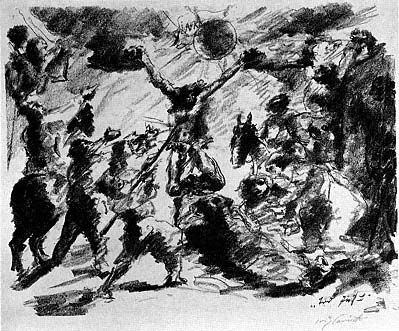The Red Christ
The figure compositions to which Corinth had once turned so frequently on account of their "universal human" significance, diminished in number as landscapes and still lifes became more meaningful in personal terms. In 1919 there were still six such paintings, but in 1920 and 1921 there were only two for each year. In 1922 there is only one, The Red Christ (see Plate 32), surely Corinth's most horrific interpretation of the subject. The simplified composition as well as the searing nature of the conception is anticipated in the watercolor of 1917 (see Fig. 136), which may well have served as a model for the painting. In the painting, however, the scene is considerably enlarged: Longinus, in the lower left corner of the panel, pierces Christ's side with a lance; another soldier, in the lower right corner, holds aloft the sponge soaked in vinegar offered to Christ just before he died. The figures of the two thieves who were crucified with Christ are dimly visible in the two upper corners. In the middle ground, at some distance, Saint John supports the Virgin, who is overcome with grief.
Although the traditional features of the scene are thus all recognizable, the painting is nonetheless no more a narrative than the watercolor of 1917. The emaciated figure of Christ, seemingly suspended from the picture frame rather than from the cross, is splayed across the pictorial field like some hieroglyphic symbol of pain. The colors have been smeared on the panel in thick globs, then scraped and scumbled with the palette knife and the brush. Virtually everywhere there are spurts of bright red.
The individual faces, like masks, embody a wide range of psychological states: evil, indifference, compassion, and unspeakable horror. Just as Christ's

Figure 169
Lovis Corinth, Crucifixion , 1923. Lithographic
crayon, 63 × 50 cm. Staatliche Museen, Berlin
(DDR).

Figure 170
Lovis Corinth, Death of Jesus , 1923. Lithograph, 50 × 64 cm, M. 694.
Hamburger Kunsthalle, Hamburg (1961/234).
Photo: Ralph Kleinhempel.
body dominates the pictorial structure, so the howling darkness of his countenance governs the painting's terrifying mood. What personal anguish must have motivated so gruesome a conception! Not even Beckmann or Nolde, who years earlier had turned to Christ's Passion in their search for paradigmatic examples of man's suffering, ever managed to approach the intensity of Corinth's brutal image of pain. The only valid comparison is with Matthias Grünewald, who has left us similarly memorable depictions of superhuman agony.
In a crayon drawing of 1923 (Fig. 169) Corinth returned to the subject of The Red Christ in slightly modified form. Here the individual figures appear as if floating in a spatial void. Like vapors that congeal temporarily, they are about to vanish. The drawing evidently served as a study for the lithograph Death of Jesus (Fig. 170) of the same year. Although in the print the narrative has been considerably amplified, here, too, the palpable character of Corinth's earlier compositions of this type has given way to the allusive expressiveness of his late style.